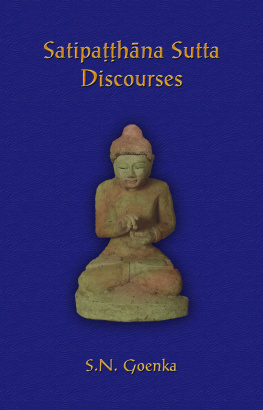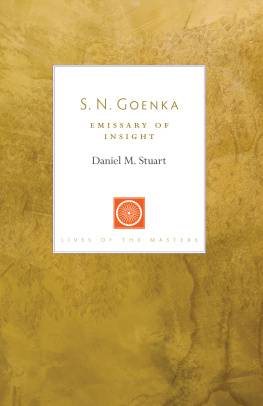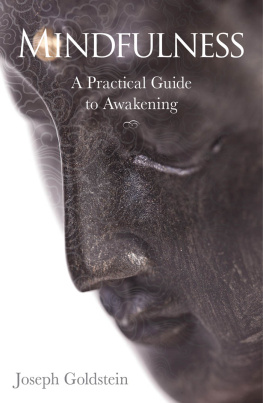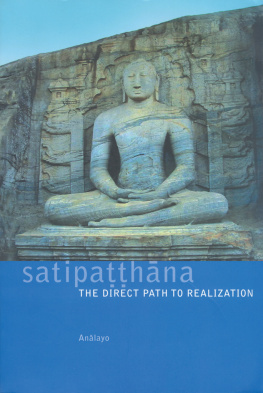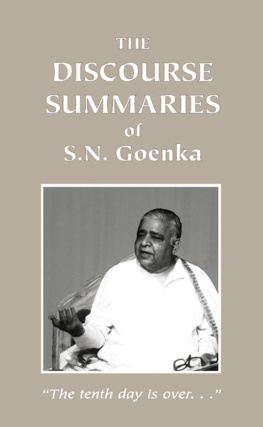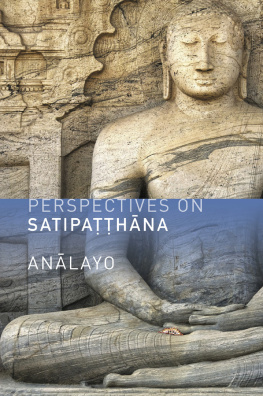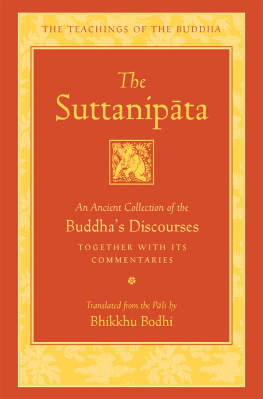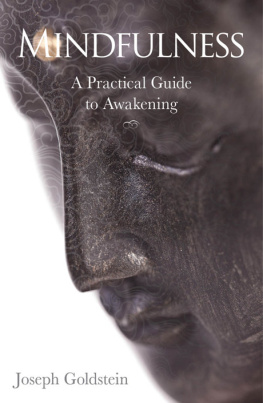Goenka - Satipatthana sutta discourses.
Here you can read online Goenka - Satipatthana sutta discourses. full text of the book (entire story) in english for free. Download pdf and epub, get meaning, cover and reviews about this ebook. year: 2015, publisher: Pariyatti Pub, genre: Religion. Description of the work, (preface) as well as reviews are available. Best literature library LitArk.com created for fans of good reading and offers a wide selection of genres:
Romance novel
Science fiction
Adventure
Detective
Science
History
Home and family
Prose
Art
Politics
Computer
Non-fiction
Religion
Business
Children
Humor
Choose a favorite category and find really read worthwhile books. Enjoy immersion in the world of imagination, feel the emotions of the characters or learn something new for yourself, make an fascinating discovery.
Satipatthana sutta discourses.: summary, description and annotation
We offer to read an annotation, description, summary or preface (depends on what the author of the book "Satipatthana sutta discourses." wrote himself). If you haven't found the necessary information about the book — write in the comments, we will try to find it.
Goenka: author's other books
Who wrote Satipatthana sutta discourses.? Find out the surname, the name of the author of the book and a list of all author's works by series.
Satipatthana sutta discourses. — read online for free the complete book (whole text) full work
Below is the text of the book, divided by pages. System saving the place of the last page read, allows you to conveniently read the book "Satipatthana sutta discourses." online for free, without having to search again every time where you left off. Put a bookmark, and you can go to the page where you finished reading at any time.
Font size:
Interval:
Bookmark:

Discourses

Talks from a course in
Mah-satipahna Sutta
condensed by Patrick Given-Wilson


Vipassana Research Publications
867 Larmon Road
Onalaska, WA 98570, USA
www.pariyatti.org

1998 by Vipassana Research Institute
All rights reserved. No part of this book may be used or reproduced in any manner whatsoever without the written permission of the Vipassana Research Institute except in the case of brief quotations embodied in critical articles and reviews.
First edition: 1998
Second edition: 2015
ISBN: 978-1-938754-90-6 (print)
ISBN: 978-1-938754-87-6 (ePub)
ISBN: 978-1-938754-88-3 (Mobi)
ISBN: 978-1-938754-89-0 (PDF)
Library of Congress Catalog Number: 2015934512
Publisher's Cataloging-in-Publication Data:
Goenka, Satyanarayana, 1924-2013
Satipahna sutta discourses : talks from a course in Mah-satipahna Sutta / S.N. Goenka ; condensed by Patrick Given-Wilson. 2nd ed.
p. cm.
LCCN: 2015934512
ISBN: 978-1-938754-90-6
1. Tipiaka. Suttapiaka. Dghanikya.MahsatipahnasuttaCriticism, interpretation, etc.2. Tipiaka. Suttapiaka. Dghanikya.MahsatipahnasuttaMeditations. 3. BuddhismDoctrines. I. Given-Wilson, Patrick. II. Title.
S.N. GOENKA, or Goenkaji as he is widely and respectfully referred to, passed away on September 29th, 2013. He was renowned in numerous countries of the world as a master teacher of meditation.
He received the technique that he taught in the 1950s from Sayagyi U Ba Khin of Burma, who had in turn received it from Saya Thet Gyi, who had received it from the Venerable Ledi Sayadaw, a monk who had received it from his own teacher, in a lineage of teachers descended directly from the Buddha. The preservation of the technique through such a long period of time is extraordinary and a cause for gratitude in those who practice it. In a world hungry for inner peace, there was a remarkable spread of the technique during Goenkajis lifetime: today, Vipassana courses are given in over 150 meditation centers as well as many temporary sites in India and around the world, attracting growing numbers (now about 100,000 people annually).
Despite his magnetic personality, Goenkaji gave credit for the success of his teaching to the efficacy of Dhamma itself. He never sought to play the role of a guru or to found any sect, cult or religious organization. He never omitted to say that he received the technique from the Buddha through a chain of teachers down to his own teacher, and to express his gratitude to them for the benefits that he had personally gained in his own meditation. He continually emphasized that he did not teach Buddhism or any kind of ism, that instead he taught a universal technique which could be practiced by people from any religious or philosophical background or belief.
The standard meditation course in this tradition is a ten days residential course. Participants commit themselves to staying on the course site for the full ten days, observing a rigorous timetable, maintaining silence for the first nine days. At the beginning of the course, they take the Five Precepts of moral conduct, as given by the Buddha to householders; that is, they undertake to refrain from killing, to refrain from stealing, to refrain from telling lies, to refrain from sexual misconduct (which involves the maintenance of complete celibacy for the duration of the course), and to refrain from taking any intoxicants. They start with the practice of npna meditation, that is, the observation of the natural breath. On the fourth day, when some concentration has developed, they switch to the practice of Vipassana, the systematic observation of the entire mind-matter phenomenon through the medium of bodily sensations. On the last full day, they practice Mett-bhvan, that is, loving kindness, or sharing the merits that they have gained with others.
Although his family was from India, Goenkaji was brought up in Burma (today Myanmar), where he learned the technique from his teacher Sayagyi U Ba Khin. After U Ba Khin authorized him as a teacher, he left Myanmar in 1969 in response to his mothers illness, to give a ten-day course for his parents and twelve others in Bombay (Mumbai). The inspiration that he aroused and the extraordinary results of his teaching led to many more such courses, first in sites around India and then later in permanent meditation centers as they were established. From 1979 onwards he also gave courses outside India, notably in Sri Lanka, Thailand, Nepal, France, the U.K., North America, Japan, Australia and New Zealand. All of these areas today have one or more centers.
In the early days of Goenkajis teaching, some meditators were confused about how to practice Vipassana. The question arose as to what was Vipassana and what was Satipahna. In fact Vipassana and Satipahna are synonymous. They are the same.
In order to dispel this misunderstanding and to enable meditators to work directly with the Buddhas words, Goenkaji gave the first Satipahna Sutta course at Dhammagiri, the main center near Mumbai, from December 16 to 22, 1981. The discipline and timetable of a ten-day course remained unchanged, but the participants could study the text of the Sutta in the break periods if they wished. Goenkajis evening discourses explained and expanded on the Sutta. In this way pariyatti (the theoretical study of Dhamma) and paipatti (the actual practice of Dhamma) were beneficially combined.
Each of the chapters of this book is a condensed version of the daily evening discourse given by Goenkaji during a Satipahna Sutta course held at Dhamma Bhmi, Blackheath, Australia, in November 1990. The book is intended as a companion volume to the Mah-satipahna Sutta, The Great Discourse on the Establishing of Awareness, with its introduction and notes, published by the Vipassana Research Institute in 1998. That publication contains the full text of the Sutta and is used as a handbook by meditation students who are attending the course. The condensed discourses in this book contain only short excerpts from the Sutta and it is not intended to be used during the course, when students are able to hear the original discourses directly. It may, however, serve as an aid to meditators after the course as a review of the content, an aid to further study of the texts for scholars, and a tool to assist with translation and better understanding for the benefit of those whose mother tongue is not English.
Liberation can only be gained by practice, never by mere discussion. These words of Goenkaji give a fitting background to the origin and reason for these discourses and for the Satipahna Sutta course itself.
Goenkaji always emphasized the importance of the actual practice of meditation; theory and study were understood as a support to the practice. In the Satipahna discourses, he warned of how unfortunate it would be if a center became devoted only to the study of theory. On
Font size:
Interval:
Bookmark:
Similar books «Satipatthana sutta discourses.»
Look at similar books to Satipatthana sutta discourses.. We have selected literature similar in name and meaning in the hope of providing readers with more options to find new, interesting, not yet read works.
Discussion, reviews of the book Satipatthana sutta discourses. and just readers' own opinions. Leave your comments, write what you think about the work, its meaning or the main characters. Specify what exactly you liked and what you didn't like, and why you think so.

